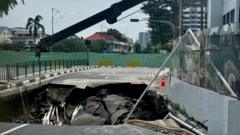When a black Mazda was swallowed by a 3m deep sinkhole on a bustling Singapore road, a group of seven migrant workers sprang into action. Using a rope, they successfully rescued the driver, with foreman Suppiah Pitchai Udaiyappan leading the charge. Their quick response made them local heroes, but it also brought attention to the ongoing struggles of Singapore's migrant workforce, primarily from countries like India, Bangladesh, and Myanmar.
Migrant workers, often burdened by low wages and harsh living conditions, form the backbone of Singapore's economy. While footage of the rescue went viral on social media, many began to question the treatment and rights of these essential laborers, who are frequently subject to exploitation and hazardous working conditions.
Advocates argue that despite recent awareness, little has changed in terms of legislative reforms to improve their conditions, such as implementing a minimum wage or protecting their rights as workers. With the COVID-19 pandemic exposing the grim realities of their living situations, the discussion has gained momentum once more.
Critics have expressed that while the workers received commendations from officials, such gestures often come without genuine change. As awareness grows, many are calling for not just recognition but for real improvements to the livelihoods of these workers.
Despite Singaporean authorities promoting transportation alternatives for workers, many still rely on unsafe flat-bed trucks, leading to tragic accidents. Activists highlight that these ongoing practices prioritize economic concerns over the basic rights of workers.
This rescue has ignited a critical dialogue about the value of these individuals who, even while enduring strenuous work and living conditions, demonstrate courage and selflessness. As Singapore contemplates its societal structure, advocates warn against seeing migrant workers merely as economic tools while demanding systemic changes to recognize their human rights and dignity.

















